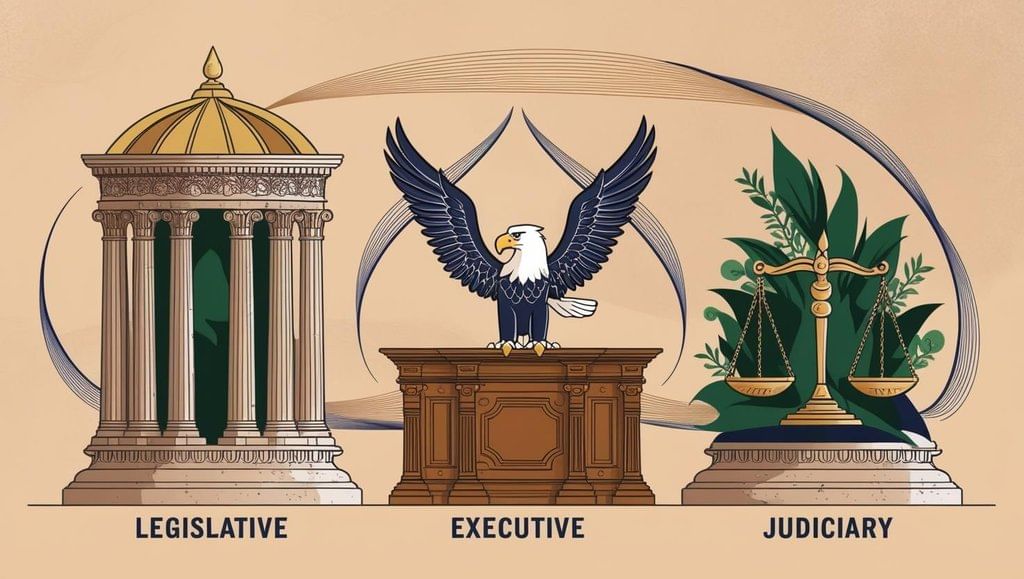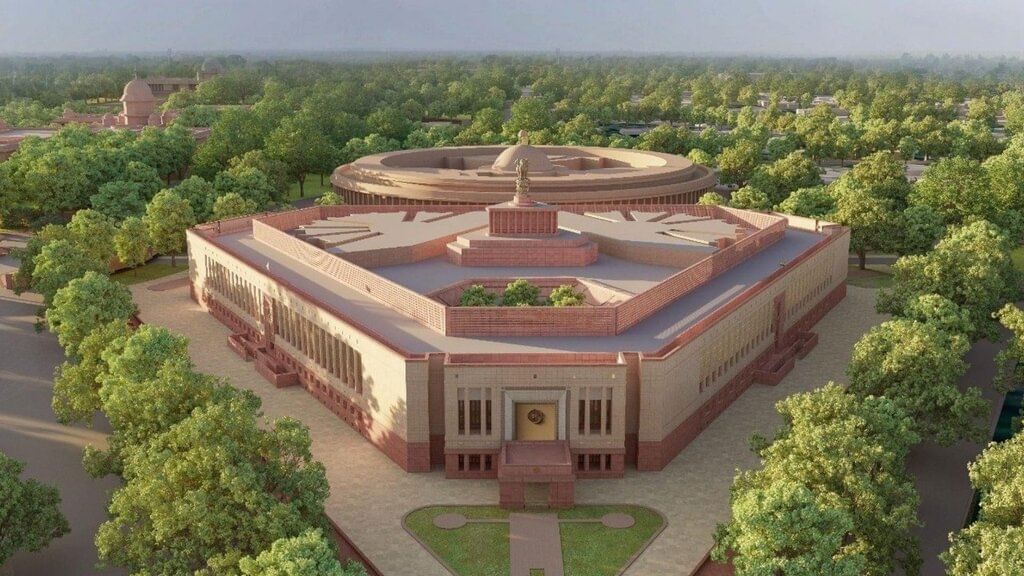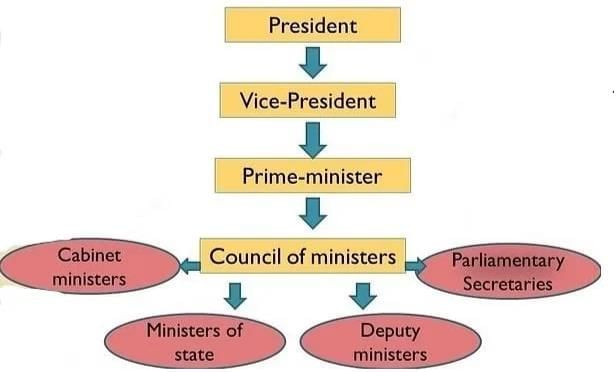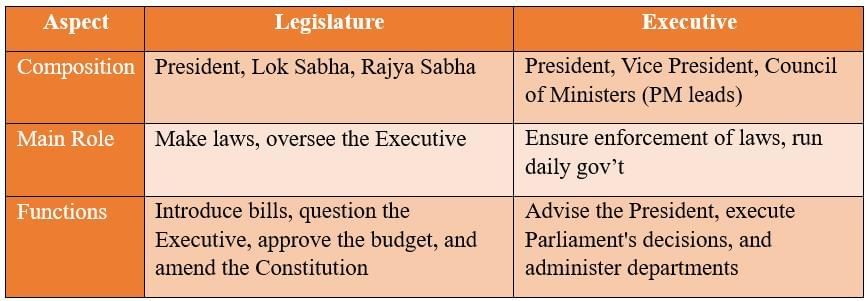Class 8 Exam > Class 8 Notes > Social Science Class 8 - New NCERT > Key Concepts: The Parliamentary System: Legislature and Executive
Key Concepts: The Parliamentary System: Legislature and Executive | Social Science Class 8 - New NCERT PDF Download
Introduction
- India’s independence led to the framing of the Constitution, establishing foundational democratic principles.
- The Constitution introduced Universal Adult Franchise, enabling all adults to vote.
- Parliament is the supreme legislative body, formed by elected representatives, and functions with the consent of the people.
- India’s democracy includes checks and balances among the Legislature, Executive, and Judiciary.

Composition of the Parliament of India
- The Parliament consists of the President, the Lok Sabha (House of the People, Lower House), and the Rajya Sabha (Council of States, Upper House).
- Lok Sabha members are directly elected; state legislatures indirectly elect Rajya Sabha members.
- The system is bicameral, accommodating the principle of federalism to balance national and regional interests.
- The maximum strength: 550 members in Lok Sabha (as per Constitution), state-wise allocation by population.

Question for Key Concepts: The Parliamentary System: Legislature and ExecutiveTry yourself:What is the Lok Sabha also known as?View Solution
Function
- Each House has a presiding officer: the Speaker for Lok Sabha; the Vice President (Chairperson) for Rajya Sabha.
- Duties include ensuring debates are orderly and accessible, with interpretation services in multiple languages.
- Parliament is responsible for law-making (legislative function) and ensuring laws are implemented (executive function).
- Council of Ministers is chosen from the MPs and is collectively responsible to the Lok Sabha.
Legislative Functions of the Parliament
- The Parliament performs key functions under four main areas:
- Constitutional function- Lawmaking
- Executive accountability
- Financial accountability
Constitutional function
- Elects the President and Vice President.
- Amends the Constitution as needed.
- Upholds constitutional values: democracy, separation of powers, federalism, Fundamental Rights, and Directive Principles.
Lawmaking
- Major role: Make laws through a rigorous procedure.
- A bill (draft law) goes through introduction, readings, debates, committee scrutiny, voting, and then gets the President’s assent to become a law.
- Example: The Right to Education Act, 2009, started as a bill and became law after passing through these steps.
- Money Bills (financial matters) can only be introduced in the Lok Sabha.
Executive accountability
- The Prime Minister and Council of Ministers implement and enforce laws.
- They are answerable to Lok Sabha, especially via Question Hour, where ministers must justify their actions and decisions.
- Parliamentary committees examine government policies and report to Parliament.
Financial accountability
- Parliament approves and monitors governmental expenditure via the annual budget process.
- Ensures government spending follows approved allocations, promoting transparency and accountability.
Executive Functions of the Parliament
- The President, Vice President, and Council of Ministers make up the Union Executive.
- They implement and administer laws passed by Parliament.

The President
- Is the nominal Head of State and Executive.
- Appoints the Prime Minister and other Ministers, gives assent to bills, and summons Parliament.
- Exercises some discretionary powers, especially during political uncertainty, like a hung Lok Sabha.
The Prime Minister and the Council of Ministers
- The Prime Minister is the real executive authority, leading the government, policy-making, and administration.
- The Council of Ministers is collectively responsible to the Lok Sabha.
- Most bills discussed and passed in Parliament are introduced by the government.
- Civil servants (bureaucrats) help implement policies and programs.

Question for Key Concepts: The Parliamentary System: Legislature and ExecutiveTry yourself: What does the Parliament mainly do?View Solution
The Judiciary — Role of Checks and Balances
- The Judiciary interprets laws and ensures all branches respect the Constitution, resolving disputes when needed.
- Checks and balances keep any one branch from becoming too powerful.
- The Judiciary can review the validity of laws and the implementation of programs, and acts as guardian of fundamental rights.
- Encourages accountability by requiring the Legislature and Executive to act within constitutional limits.
Legislative and Executive Functions at the State Level
- Every state has a legislature (Vidhan Sabha, and sometimes Vidhan Parishad) and an Executive (Governor as head of state, Chief Minister as executive head).
- States make laws on matters in the State and Concurrent Lists; Parliament controls Union and Concurrent matters.
- Most states have a unicameral legislature, but some have a bicameral system.
- Structure mirrors the Union level to a large extent, promoting federalism.
Challenges to the Effective Functioning of the Legislatures
- Common challenges include absenteeism, disruptions, low debate quality, and a slow legislative process.
- Parliament meets in three sessions a year—Budget, Monsoon, and Winter Sessions. The actual productivity (hours worked vs. scheduled) can be low due to disruptions.
- Presence of members with criminal backgrounds and divisive debates can undermine public trust.
- Efficiency and effectiveness of Parliament and Assemblies are vital for democracy to deliver on citizens’ needs.
- Citizen participation and awareness help keep the system strong; the media also plays a key role in communicating concerns and informing the public.
The document Key Concepts: The Parliamentary System: Legislature and Executive | Social Science Class 8 - New NCERT is a part of the Class 8 Course Social Science Class 8 - New NCERT.
All you need of Class 8 at this link: Class 8
|
31 videos|128 docs|7 tests
|
FAQs on Key Concepts: The Parliamentary System: Legislature and Executive - Social Science Class 8 - New NCERT
| 1. What is the composition of the Parliament of India? |  |
Ans. The Parliament of India is a bicameral legislature, which means it consists of two houses: the Lok Sabha (House of the People) and the Rajya Sabha (Council of States). The Lok Sabha is made up of Members of Parliament (MPs) directly elected by the people, while the Rajya Sabha consists of members elected by the state legislatures and appointed by the President of India. Together, these two houses are responsible for making and passing laws in the country.
| 2. What are the main legislative functions of the Parliament? |  |
Ans. The main legislative functions of the Parliament include the formulation, discussion, and passage of laws. This involves introducing bills, debating them, and voting on their approval. The Parliament also has the power to amend existing laws, and it plays a crucial role in scrutinizing government policies and expenditures through various committees.
| 3. How does the Parliament of India perform its executive functions? |  |
Ans. The Parliament performs executive functions by overseeing the actions of the government, ensuring accountability and transparency. This includes questioning government officials, approving budgets, and conducting debates on government policies. The Parliament also has the power to approve treaties and international agreements, which are essential for the country's foreign relations.
| 4. What is the role of the judiciary in the context of checks and balances within the Indian government? |  |
Ans. The judiciary plays a vital role in maintaining checks and balances within the Indian government by interpreting laws and ensuring that both the legislature and executive act within the framework of the Constitution. It has the authority to review laws passed by the Parliament and can strike down any legislation that violates constitutional provisions or fundamental rights, thereby protecting the rule of law.
| 5. What are some challenges faced by the legislatures in India? |  |
Ans. Challenges faced by the legislatures in India include issues such as political instability, a lack of adequate resources, and the influence of money and muscle power in elections. Additionally, there are concerns about the effectiveness of legislative debates and the quality of laws being passed, as well as the need for better representation of diverse groups within the population. These challenges can hinder the effective functioning of the legislatures in fulfilling their roles.
Related Searches
















